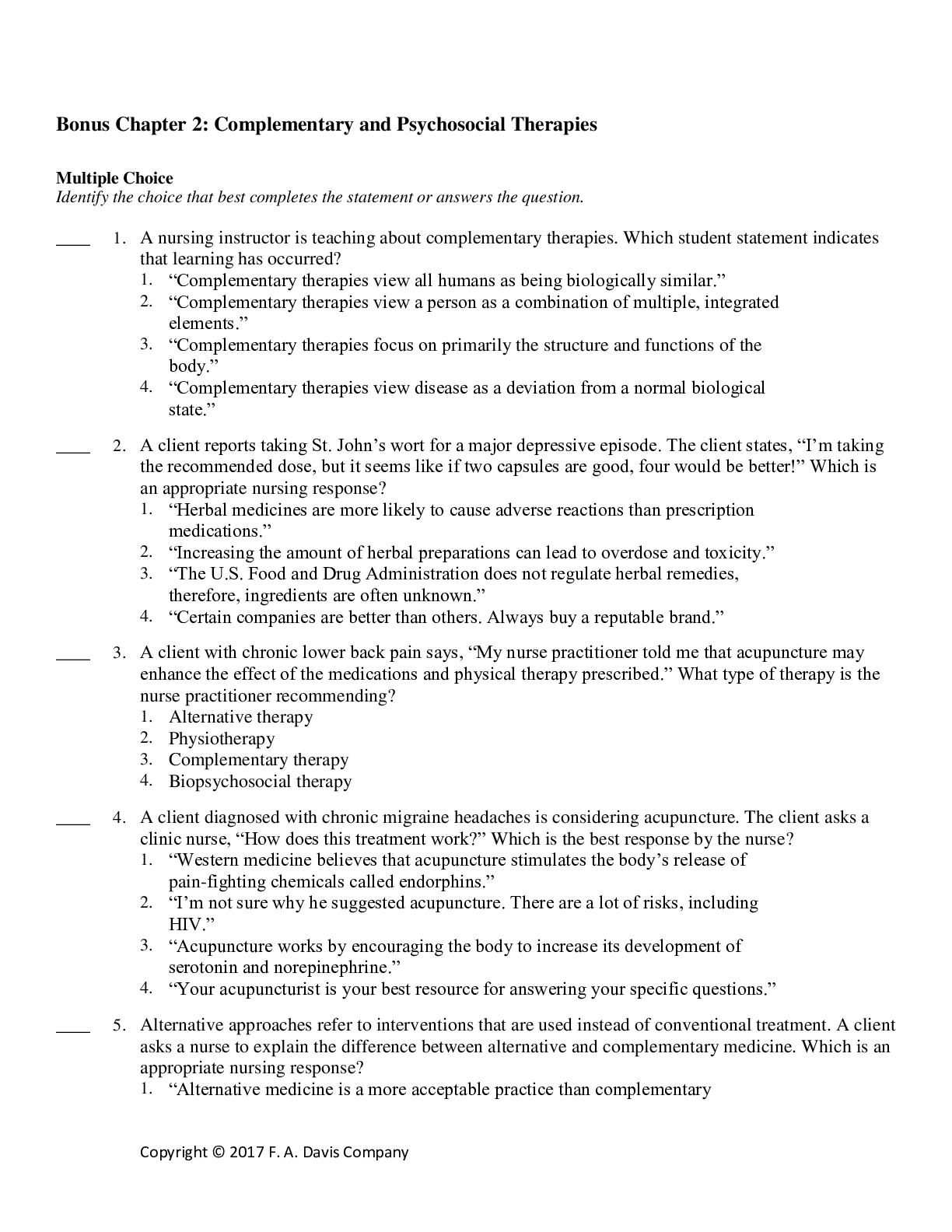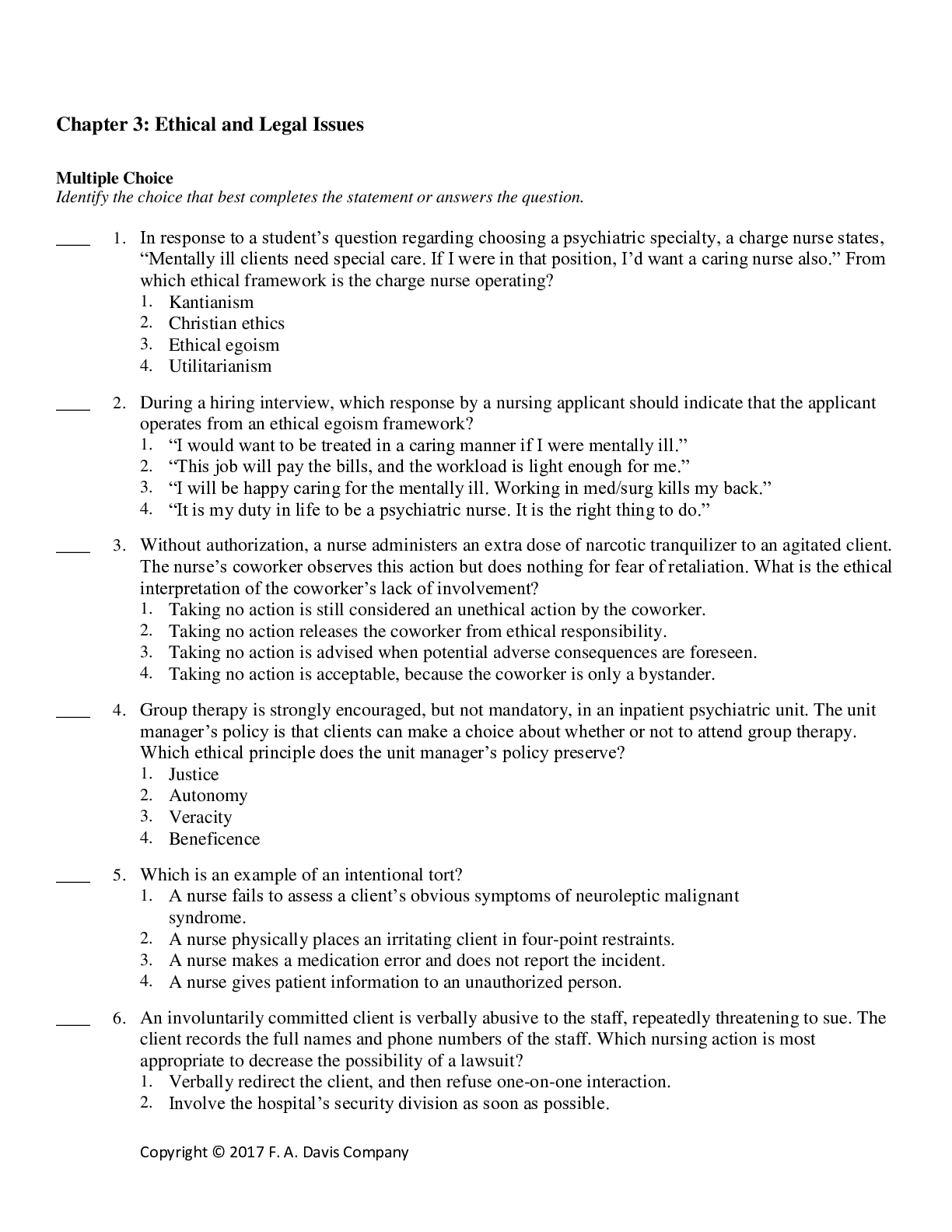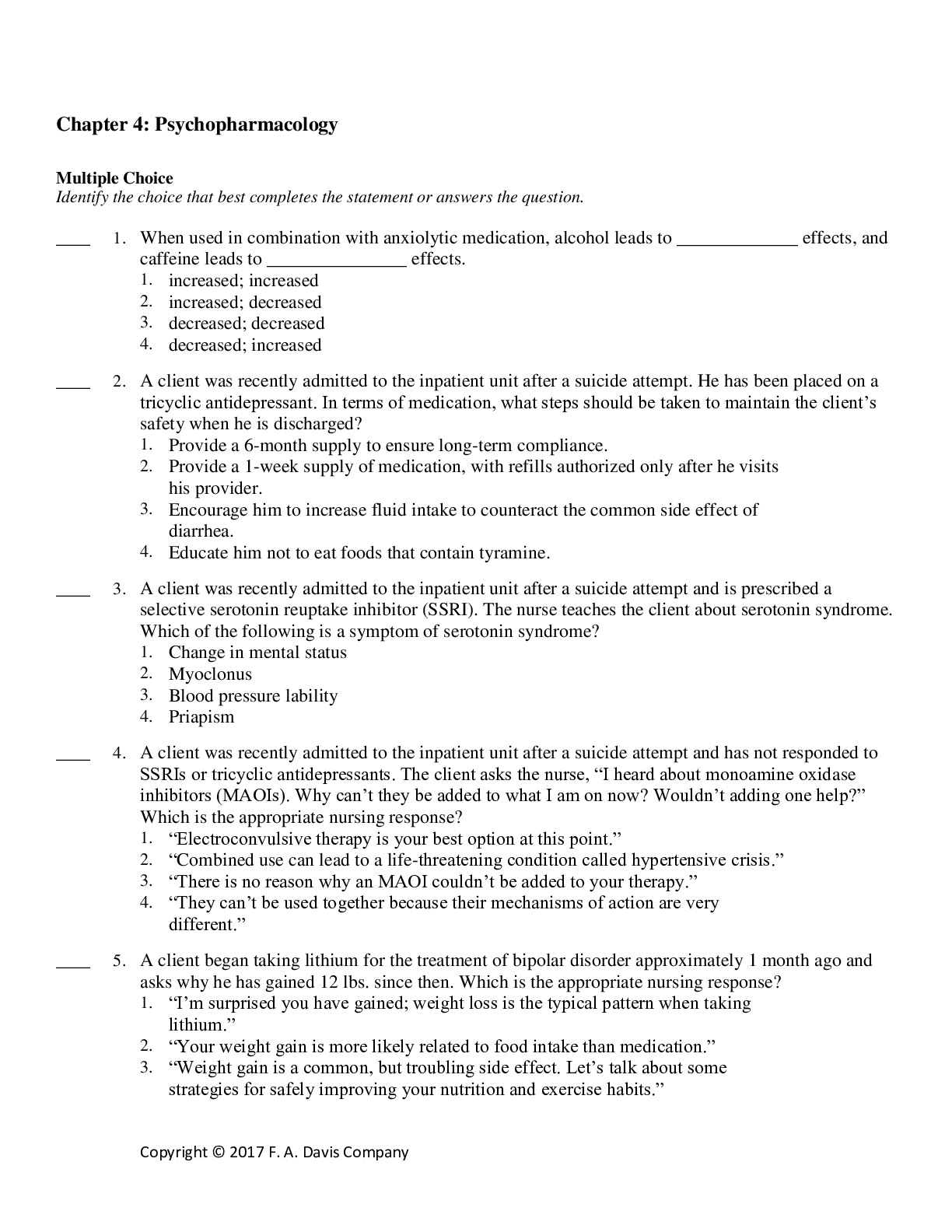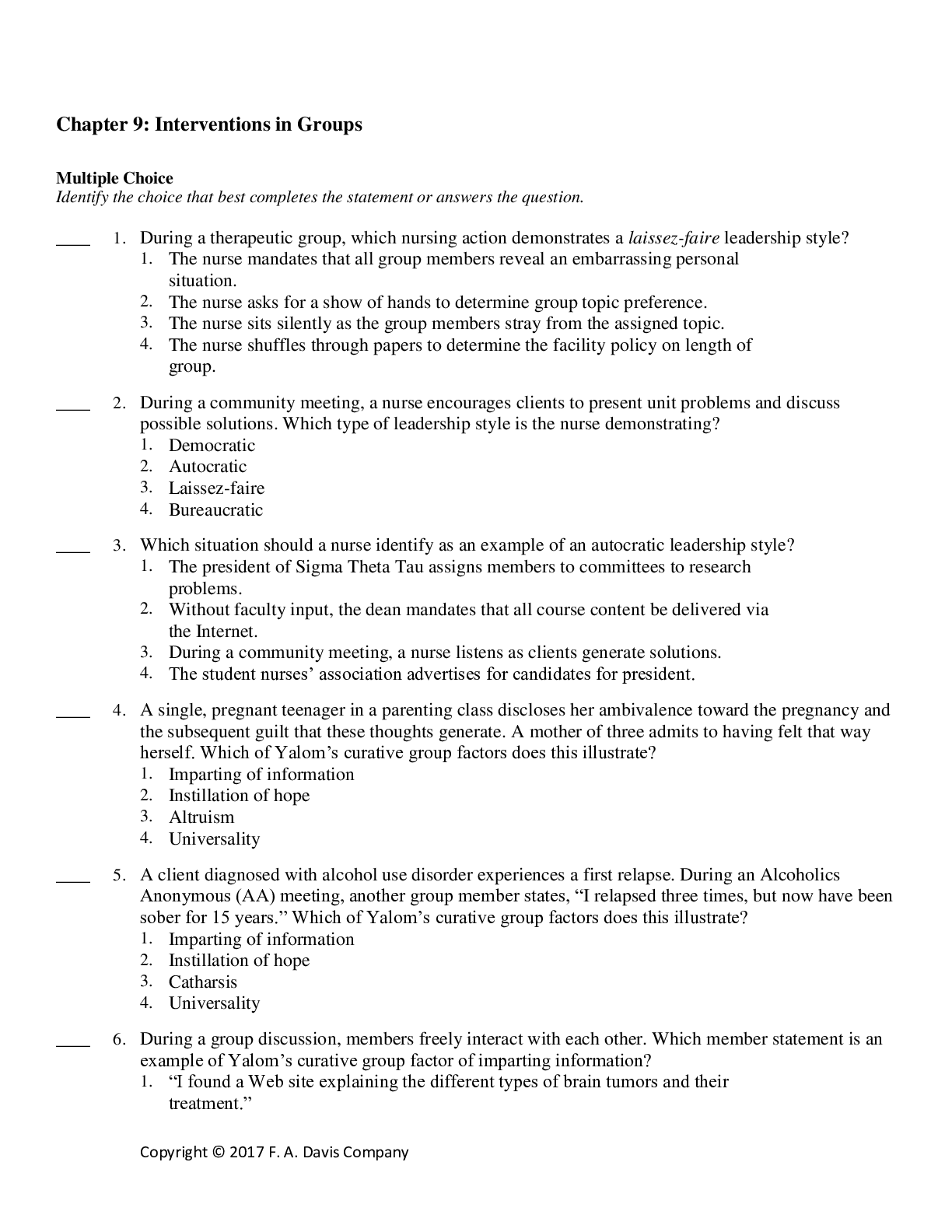*NURSING > QUESTIONS & ANSWERS > Chapter 5: Cultural and Spiritual Concepts Relevant to Psychiatric/Mental Health Nursing. With Answe (All)
Chapter 5: Cultural and Spiritual Concepts Relevant to Psychiatric/Mental Health Nursing. With Answers Explained
Document Content and Description Below
Multiple Choice Identify the choice that best completes the statement or answers the question. ____ 1. An African American youth, growing up in an impoverished neighborhood, seeks affiliation with... a black gang. Soon he is engaging in theft and assault. What cultural consideration should a nurse identify as playing a role in this youth’s choices? 1. Most African American homes are headed by strong, dominant father figures. 2. Most African Americans choose to remain within their own social organization. 3. Most African Americans are uncomfortable expressing emotions and seek out belonging. 4. Most African Americans have few religious beliefs, which contributes to criminal activity. ____ 2. Northern European Americans value punctuality, hard work, and the acquisition of material possessions and status. A nurse should recognize that these values may contribute to which form of psychopathology? 1. Dissociative disorders 2. Alzheimer’s dementia 3. Stress-related disorders 4. Schizophrenia-spectrum disorders ____ 3. A community health nurse is planning a health fair at a local shopping mall. Which middle-class socioeconomic cultural group should the nurse anticipate would most value preventive medicine and primary health care? 1. Northern European Americans 2. Native Americans 3. Latino Americans 4. African Americans ____ 4. Which rationale by a nursing instructor best explains why it is challenging to globally classify the Asian American culture? 1. Extremes of emotional expression prevent accurate assessment of this culture. 2. Suspicion of Western civilization has understandably resulted in minimal participation in cultural research. 3. The small size of this subpopulation makes research virtually impossible. 4. The Asian American culture includes individuals from Japan, China, Vietnam, Korea, and other countries. ____ 5. A Latin American woman refuses to participate in an assertiveness training group. Which cultural belief should a nurse identify as most likely to affect this client’s decision? 1. Future orientation causes the client to devalue assertiveness skills. 2. Decreased emotional expression makes it difficult to be assertive. 3. Assertiveness techniques may not be aligned with the client’s definition of the female role. 4. Religious prohibitions prevent the client’s participation in assertiveness training. ____ 6. A Latin American man refuses to acknowledge responsibility for hitting his wife, stating instead, “It’s the man’s job to keep his wife in line.” Which cultural belief should a nurse associate with this client’s behavior? 1. That families are male-dominated, with clear male–female role distinctions 2. That religious tenets support the use of violence in a marital context 3. That the nuclear family is female-dominated and the mother has ultimate authority 4. That marriage dynamics are controlled by dominant females in the family ____ 7. When working with clients of a particular culture, which action should a nurse avoid? 1. Making direct eye contact 2. Assuming that all individuals who share a culture or ethnic group are similar 3. Supporting the client in participating in cultural and spiritual rituals 4. Using an interpreter to clarify communication ____ 8. To effectively plan care for Asian American clients, a nurse should be aware of which cultural factor? 1. Obesity and alcoholism are common problems. 2. Older people maintain positions of authority within the culture. 3. “Tai” and “chi” are the fundamental concepts of Asian health practices. 4. Asian Americans are likely to seek psychiatric help. ____ 9. A Native American client is admitted to an emergency department (ED) with an ulcerated toe, secondary to uncontrolled diabetes mellitus. The client refuses to talk to a physician unless a shaman is present. Which nursing intervention is most appropriate? 1. Try to locate a shaman who will agree to come to the ED. 2. Explain to the client that “voodoo” medicine will not heal the ulcerated toe. 3. Ask the client to explain what the shaman can do that the physician cannot. 4. Inform the client that refusing treatment is a client’s right. ____ 10. When planning client care, which folk belief that may affect health-care practices should a nurse identify as characteristic of the Latino American culture? 1. The root doctor is often the first contact made when illness is encountered. 2. The yin and yang practitioner is often the first contact made when illness is encountered. 3. The shaman is often the first contact made when illness is encountered. 4. The curandero is often the first contact made when illness is encountered. ____ 11. In what probable way should a nurse expect an Asian American client to view mental illness? 1. Mental illness relates to uncontrolled behaviors that bring shame to the family. 2. Mental illness is a curse from God related to immoral behaviors. 3. Mental illness is cured by home remedies based on superstitions. 4. Mental illness is cured by “hot and cold” herbal remedies. ____ 12. Which cultural considerations should a nurse identify as reflective of Western European Americans? 1. They are present-time oriented and perceive the future as God’s will. 2. They value youth, and older adults are commonly placed in nursing homes. 3. They are at high risk for alcoholism, because of a genetic predisposition. 4. They are future oriented and practice preventive health care. ____ 13. A nurse should recognize that clients who have a history of missed or late medical appointments are most likely to come from which cultural group? 1. African Americans 2. Asian Americans 3. Native Americans 4. Jewish Americans Multiple Response Identify one or more choices that best complete the statement or answer the question. ____ 14. When interviewing a client of a different culture, which of the following questions should a nurse consider? (Select all that apply.) 1. Would using perfume products be acceptable? 2. Who may be expected to be present during the client interview? 3. Should communication patterns be modified to accommodate this client? 4. How much eye contact should be made with the client? 5. Would hand shaking be acceptable? ____ 15. A female nurse is caring for an Arab American male client. When planning effective care for this client, the nurse should be aware of which of the following cultural considerations? (Select all that apply.) 1. Limited touch is acceptable only between members of the same sex. 2. Conversing individuals of this culture stand far apart and do not make eye contact. 3. Devout Muslim men may not shake hands with women. 4. The man is the head of the household, and women take on a subordinate role. 5. Men of this culture are responsible for the education of their children. ____ 16. In which of the following cultural groups should a nurse expect to find assessment of mood and affect most challenging, owing to the characteristics of the groups? (Select all that apply.) 1. Arab Americans 2. Native Americans 3. Latino Americans 4. Western European Americans 5. Asian Americans ____ 17. A nursing instructor is developing a lesson plan to teach about the Northern European American culture. Which of the following information should be included? (Select all that apply.) 1. About half of first marriages end in divorce in this cultural group. 2. This cultural group does not use preventive medicine and primary health care. 3. Punctuality and efficiency are highly valued in this cultural group. 4. This cultural group tends to be future oriented. 5. A typical diet of this cultural group includes rice, vegetables, and fish. ____ 18. The United States, viewed as a “melting pot” of multiple worldwide ethnic groups, has its own unique culture that impacts the health and care of individuals. Which of the following are characteristics common to U.S. culture? (Select all that apply.) 1. The culture values independence, self-reliance, and determining one’s life. 2. There is a strong emphasis on achievement in jobs, sports, and physical beauty. 3. Constructive criticism is considered personally offensive. 4. The culture favors structured and formal behaviors, speech, and relationships with others. 5. Overconsumption of food in this culture leads to increased obesity and decreased health. Completion Complete each statement. 19. ___________________ exists within each individual, regardless of belief system, and serves as a force for interconnectedness between the self and others, the environment, and a higher power. [Show More]
Last updated: 1 year ago
Preview 1 out of 14 pages
Instant download

Buy this document to get the full access instantly
Instant Download Access after purchase
Add to cartInstant download
Reviews( 0 )
Document information
Connected school, study & course
About the document
Uploaded On
Jan 27, 2020
Number of pages
14
Written in
Additional information
This document has been written for:
Uploaded
Jan 27, 2020
Downloads
0
Views
52


























